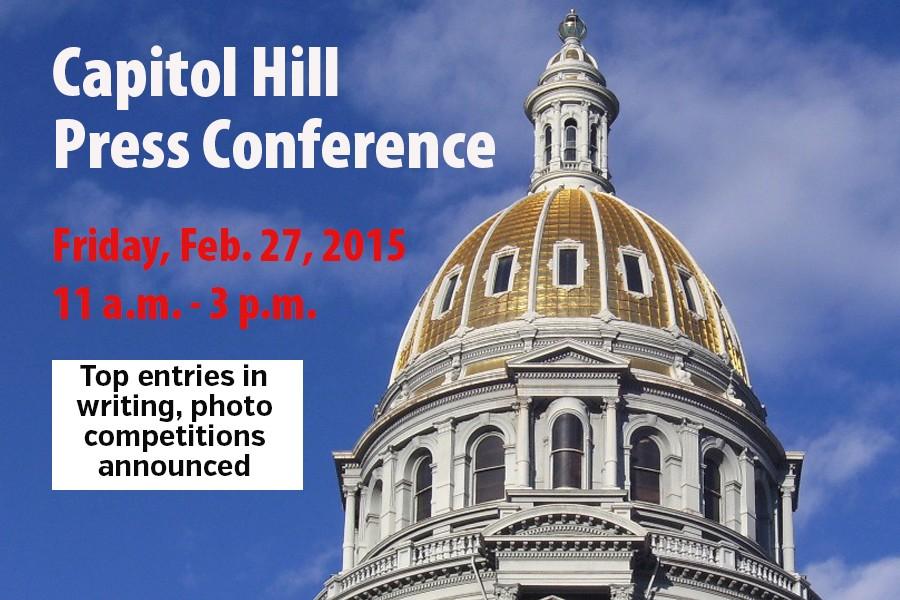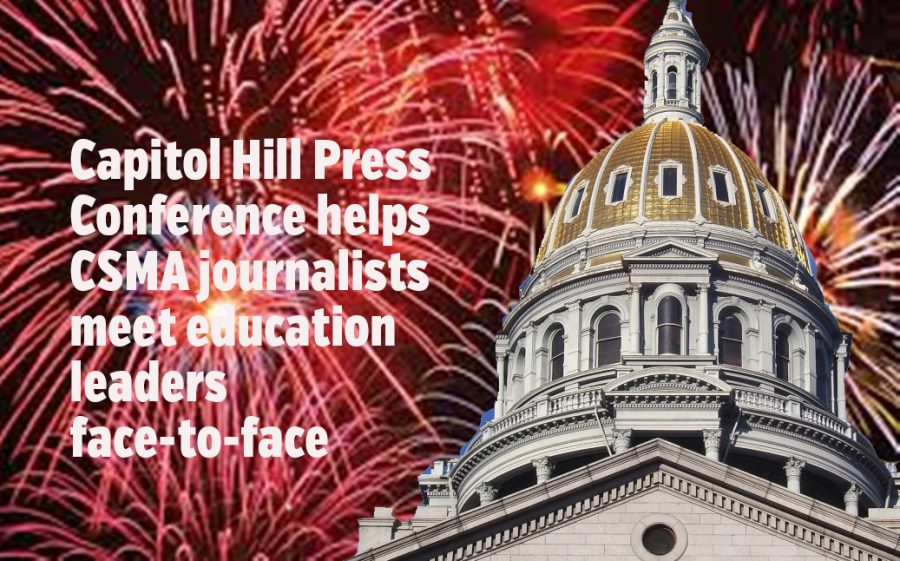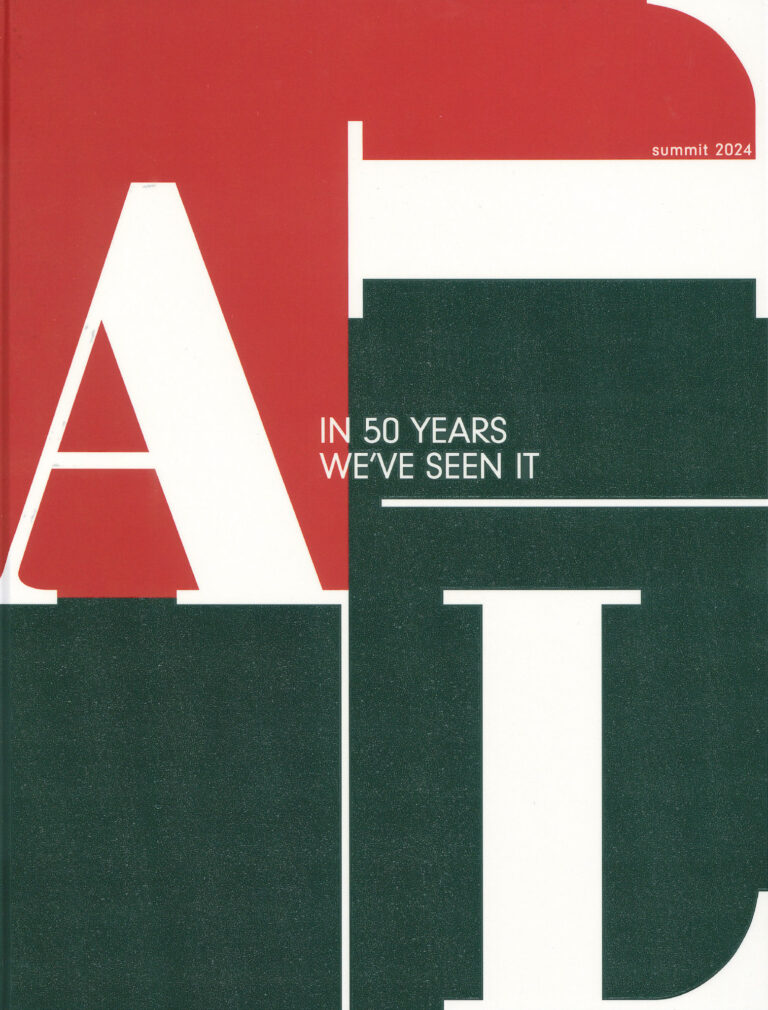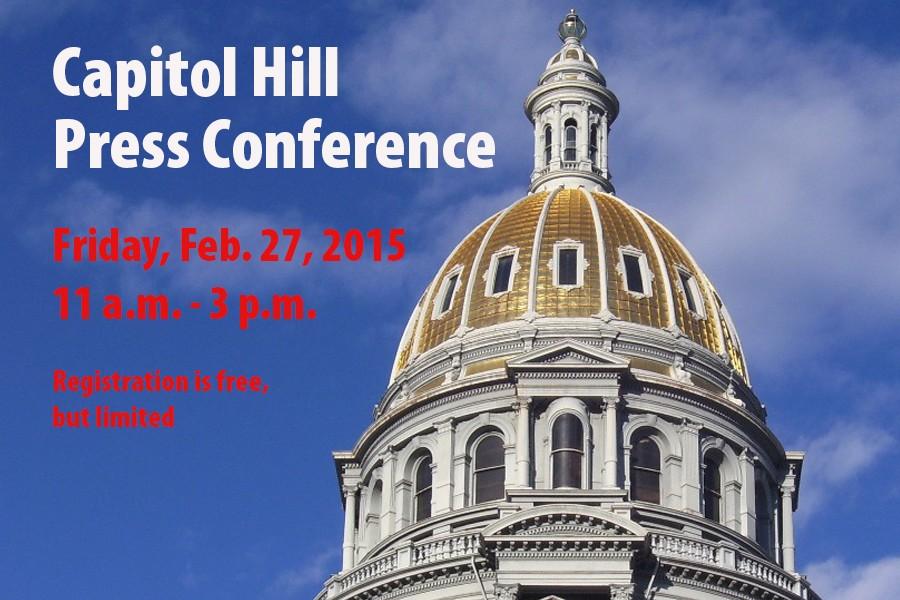The 33rd edition of the Capitol Hill Press Conference brought 41 student journalists and 9 advisers to the Old Supreme Court Chambers of the state capitol to hear from a working journalist and two state legislators on Feb. 27. Many of those students also took advantage of the 11 a.m. start to spend the morning visiting their own legislators, interviewing other government officials, and touring the capitol building.

Following the press conferences with Denver Post reporter Jordan Steffen, and Representatives Paul Lundeen and Millie Hamner, writers were given 90 minutes to plan and write either a news-feature on some aspect of the day or a commentary on an issue that arose during the day. Photojournalists were asked to write captions and submit 3-5 photos within three days of the event.
Photo entries were judged based on quality and narrative values of the images, plus the captions. First place: Evan Malone, Rocky Mountain HS. Second place: Forrest Czarnecki, Conifer HS. Third place: Savannah Olmstead, Palmer Ridge HS. Honorable mention: Kaylee Eastridge, Arapahoe HS, and Sabrina Pacha & Chaye Gutierrez, Standley Lake HS.
Top submissions will receive certificates, mailed to their advisers. Here are some examples of the best work:
FIRST PLACE NEWS-FEATURE WRITING
by Katie Pickrell and Kelsey Pharis / Mountain Vista HS
Funding is arguably Colorado’s largest educational issue, mainly due to the broadened problems regarding where money is spent and how it is proved effective. Public education in Colorado accounts for approximately 26 percent of the total state expenditures.
“Money is a necessary but not sufficient input,” Lt. Gov. Joseph Garcia said.
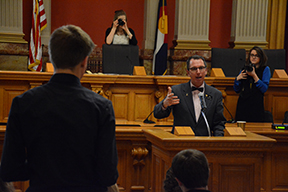
Though Colorado is ranked ninth in overall educational performance, the state falls forty-first in funding per pupil at just over 8500 dollars (thus leaving large gaps in effective funding). Because Colorado is the only state with Taxpayer Bill of Rights, it isn’t possible to raise revenue through higher taxes without the approval of the people.
Many argue that educational systems need more money to produce a more secure and productive learning environment. The top ranked schools in the United States, though inconsistent with funding in some places, habitually align with higher funding.
“[We should] give money to students to have a measured pathway that allows the students and parents to choose the way that would the best possible education to their children,” state Rep. Paul Lundeen said. Lundeen is a proponent of encouraging the utilization of charter schools, but maintains the belief that public education in the United States is “a sphere in which more dollars spent has not translated into a better education for our children.”
One of the largest arguments regarding Colorado’s educational standards lies in standardized testing. Mandates such as Colorado Measures of Academic Success (CMAS) or the Partnership for Assessment of Readiness of College and Careers (PARCC) have been criticized for their irrelevance to students.
Standardized testing, while providing a basis by which to judge educational prosperity across large amounts of students, cannot be defined as an accurate assessment of student achievement and teacher proficiency.
“How do we improve quality and how do we make it consistent?” Garcia rhetorically questioned of the mandated standards for Colorado schools. “Students who show up for college– they may both have a high school diploma that was just issued a few months earlier, but they come in at totally different levels college readiness and preparation.”
Garcia believes one of the most pervasive issues in Colorado public education is the lack of consistency between districts. “In some districts 100 percent of kids test into remedial courses and in others virtually none do.”
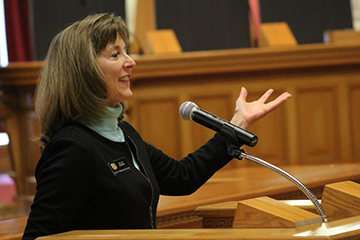
Because most students either do not understand the importance of government-mandated tests (or simply do not care) they are highly unlikely to utilize their best efforts towards taking them.
“Students don’t like it and they don’t see the value in it,” Garcia said.
This provides the idea that standardized testing is nothing but a waste of time. Many would argue it is even more important is that the mandates are also a waste of scarce resources.
“We have gone overboard for standardized testing at this point,” state Rep. Millie Hamner (D) said. “There’s a lot of state mandated tests and local school districts also have their own tests.” The idea Hamner supports is to find the delicate balance between the amount of state mandates and the acknowledgement of the individual needs of students.
Without a system in place to judge the prosperity of students across a mandated line of standards, it’s impossible to know exactly how states compare to each other. The lack of uniformity in testing could also prevent the United States as a whole from competing on an educational level with foreign nations.
“We’re working with other colleges in the state to see if they will use the PARCC test at least for placement into college level classes,” Garcia said. “With PARCC being brand new, we don’t know how it will work, but we think we know how it could work.”
Garcia hopes that providing a greater purpose to the PARCC tests for students will allow them to provide greater effort into the exam. “We want everybody to have to opportunity to get into college, so we have to do assessments along the way and do course corrections along the way,” Garcia said.
So far, Colorado has yet to find an appropriate fixed system to determine success of either teachers or students, especially considering that only one college (Adams State College) has agreed to include PARCC testing scores in class admissions. Still, district and state mandated testing accounts for 50 percent of teacher payroll.
The PARCC assessment has not proved itself to be a solution for Colorado’s issues regarding conformity and cost efficiency yet, but a method of standardized testing that is implicated through the states may be helpful.
“The standards are the floor, not the ceiling,” Garcia said.
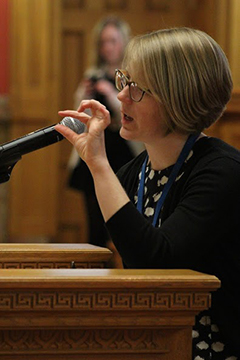
SECOND PLACE NEWS-FEATURE WRITING
by Ashley Hopko / Conifer HS
Last Standing Data Bill Under Fire
Data privacy of students has been a topic of recent controversy. Senate Bill 15-173 was written in an attempt to limit the use of sensitive student information that has the potential to cause harm to students from being used by 3rd party vendors.
The bill is sponsored by Senator Chris Holbert. It is one of three major bills that is still alive and under review that deals with student and education privacy issues. It was supposedly brought to Senator Holbert by a group of parents who are concerned that information about their children is being supplied to outside sources.
The term “Vendors” is often used in the actual bill and refers to an operator of an internet web site/ outside company that processes student information or data.
Jane Urschel is a lobbyist who also used to be on the Jefferson County School Board. She is helping to write senate bill 15- 173. She referred to the bill as “cutting edge,” and said “Technology has gotten ahead of our society. We’re going to have to catch up and figure out what fences need to be built (to protect privacy).”
Her only concern about the bill is that it will scare away potential vendors from investing in the state of Colorado. “We do need the people who store data, but we need to put regulations on them,” said Urschel.
The bill was put under scrutiny when it was referred to as a “strike below amendment” by Representative Paul Lundeen at a student press conference on February 27th, 2015. A strike though amendment is an amendment that had undergone major rewrites and changes. “We get to a point where the amendments being offered on a bill are so complicated that to keep track of the amendments are more difficult than it’s worth,” said Lundeen.
Jefferson County Superintendent Dan McMinimee stated that there have been serious data concerns in the Jefferson County district before. “I think there has to be a balance there… between what data do we collect and what data do we release,” said McMinimee. He gave an example for high school students about an option on the ACT to check a box that would allow students to release their test scores and personal contact information to colleges.
“This bill will come down hard on vendors. It will say ‘we will hold you accountable,” said Urschel, who is still a key supporter for the bill despite the conflict.

FIRST PLACE COMMENTARY WRITING
by Noah Fogelberg / Rocky Mountain HS
Deep in the halls of Colorado’s State Capitol building, two legislators from competing parties, Rep. Paul Lundeen (R) and Rep. Millie Hamner (D), argued their ideas for improving the state’s educational system.
In today’s hostile political climate, one would expect stark differences between the two politicians’ remarks. Surprisingly, the proposals that were brought up had much more in common than they differed. Despite challenges within Colorado’s legal code and a divided legislature, the remarks made by each politician gave me hope that education may be one area in which there is hope.
Providing adequate funding to education in Colorado is one of the more daunting tasks a government could face. The Taxpayer Bill of Rights (TABOR), which was passed in 1992, forces the Colorado General Assembly to put any and all tax increases up to a vote of the people. In the face of dramatically decreasing available funds for education, the Assembly has their hands tied. Seeing as a tax increase would be the only way to increase revenue to pay for educational funding, the Assembly is kept from directly providing funding to education. Instead, it is forced to ask Colorado’s voters to approve tax increases, which invariably fail. Most recently, Amendment 66 failed in 2013.
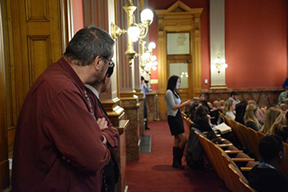
“The most effective way to increase funding to education is by way of localities. School districts can ask local governments to approve property tax increases, which is usually more likely to happen than the voters approving a statewide tax increase,” Loren Collins, legislative assistant to Democratic Rep. Dave Young, said.
Hamner and Lundee both agreed that there is a significant lack of funding for education. Lundeen proposed a voucher program, and Hamner criticized TABOR. Personally, I believe TABOR restricts government from being able to adequately fund education, and a voucher program, as Lundeen said, would help parents make the right education decisions for their children. These two ideas combined, would be one step towards improving education.
Both agreed that there is value in keeping teachers and students accountable, but standardized tests as they currently are, are not the way to go.
Another aspect that both Lundeen and Hamner spoke of, is the process of standardized testing.
“I believe we are leaning too heavily in the side of over-testing,” Hamner said.
This reflected a viewpoint common in the Colorado General Assembly, that standardized tests are not preparing students for the real world.
“Students have no motivation to do well on these tests,” Lundeen said.

Both politicians have a point. The usefulness of standardized testing goes down significantly when test days take away from useful class days. Combined with the fact that students are provided literally no reason to do well on these tests. They do not hear about their scores until over a year later and are never held accountable.
This is obviously a system doomed to fail.
In the modern political climate in which politicians from opposing parties rarely agree, it was refreshing to hear Lundeen and Hamner find common ground in perhaps Colorado’s most pertinent issue: education.
SECOND PLACE COMMENTARY WRITING
by John Bellipanni and Tara O’Gorman / Mountain Vista HS
Partnership for Assessment of Readiness of College and Careers (PARCC): Colorado’s latest ploy to ‘advance’ education?
Who hates it?
Students.
Teachers.
School Boards.
Who likes it? No one.
PARCC is a controversial subject, but do the benefits actually outweigh the risks?

Students are the major factor.
“There is a gap in the [reliability of standardized tests],” Colorado Rep. Paul Lundeen (R) said. Lundeen believes students begin to think, “Wait a second, this test isn’t really meaningful to me.”
No, it’s not.
The PARCC test is essentially a waste of time. Students have no dog in the fight, why would they try?
Teachers are affected too.
It is no secret that teachers around Colorado are salty over recent reforms in staff evaluations. Adding an invalid test, with gaps, to the mix would send any reasonable teacher over the edge.
Colorado Lieutenant Governor Joe Garcia believes there are flaws in using tests like PARCC to assess teachers. “It’s not in [students’] interest to protect the teachers.” When students can purposefully influence teachers’ pay, Garcia believes, there is an issue of reliability.

School Boards don’t support the use of over-testing, either.
“There needs to be accountability in students making progress toward success,” Douglas County School Board President Kevin Larsen said. “We’ve got to get back to getting meaningful tests that help us change and adjust the structure.” Larsen, like Lundeen, believes assessments have lost credibility in the district. “As students grow older they begin to realize, ‘this doesn’t matter to me.’”
It is yet to be determined whether PARCC testing is a colossal failure with practically no application. However, it does have potential and so much can be done. Rather than using PARCC to an inaccurate measure of student and teacher growth. It should be a mechanism for pursuing higher education. Why not reward students with their performance on PARCC testing? Scholarships could be an efficient vessel for more accurate results, benefiting students, teachers and administrators alike.
But, until these measures are taken, PARCC testing will continue to be a joke to students.
Third place in Commentary went to Lindsey Archipley, Arapahoe HS, and Honorable mention in Commentary went to Nicole Heetland and Olivia Koontz, from Standley Lake HS.



